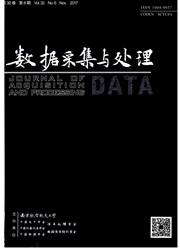

 中文摘要:
中文摘要:
异步操控性是脑机接口走向实际应用的关键技术之一.其关键点在于寻找一种可有效区分脑机接口工作状态和空闲状态的指标.建立了针对P300脑机接口的刺激起始异步(SOA)扰动模型,在仿真实验和实测数据中观察到SOA扰动谱线,并根据所提出的模型给出了合理解释.研究了SOA扰动的频域特性,结果表明,当SOA位于220 ms附近时,SOA扰动的强度最大,而当SOA低于150 ms时,SOA扰动强度将急剧减小.同时SOA扰动所具有的锁相性使得可以通过时域相干平均法进一步提高信噪比.SOA扰动可作为脑机接口处于工作状态的标志,为异步脑机接口的实现提供了一种新的研究思路.
 英文摘要:
英文摘要:
Asynchronous operating performance is one of the vital factors towards the practical use of brain computer interfaces (BCIs).The key point is to find an indicator from brain activities that can effectively distinguish between control states and non-control states of the BCI system.A stimulus onset asynchrony (SOA) perturbation analysis model is built for the P300 BCI.Spectral lines of the SOA perturbation are observed in both the simulation experiment and real experiments,which can be explained by the current analysis model.It turns out that the strength of the SOA perturbation is largest when SOA is around 220 ms,but it decreases dramatically when SOA becomes lower than 150 ms.The phase-locking property of the SOA perturbation can be used to improve its signal-to-noise ratio.The SOA perturbation can be used as an asynchronous indicator of the BCI system and it gives a new direction for the implementation of asynchronous BCIs.
 同期刊论文项目
同期刊论文项目
 同项目期刊论文
同项目期刊论文
 Improved particle filtering based algorithm for time delay and symbols joint estimation of PSK signa
Improved particle filtering based algorithm for time delay and symbols joint estimation of PSK signa A novel joint parameter estimation method based on fractional ambiguity function in bistatic multipl
A novel joint parameter estimation method based on fractional ambiguity function in bistatic multipl Fractional Time Delay Estimation Algorithm Based on the Maximum Correntropy Criterion and the Lagran
Fractional Time Delay Estimation Algorithm Based on the Maximum Correntropy Criterion and the Lagran Parameter estimation based on fractional lower order statistics and fractional correlation in wideba
Parameter estimation based on fractional lower order statistics and fractional correlation in wideba Joint estimation of time difference of arrival and frequency difference of arrival for cyclostationa
Joint estimation of time difference of arrival and frequency difference of arrival for cyclostationa U-shaped bow-tie magneto-electric dipole antenna with a modified horned reflector for ultra-wideband
U-shaped bow-tie magneto-electric dipole antenna with a modified horned reflector for ultra-wideband A Differentially Driven Dual-Polarized Dual-Wideband Complementary Antenna for 2G/3G/LTE Application
A Differentially Driven Dual-Polarized Dual-Wideband Complementary Antenna for 2G/3G/LTE Application Dual-Wideband Complementary Antenna with A Dual-Layer Cross-ME-Dipole Structure for 2G/3G/LTE/WLAN A
Dual-Wideband Complementary Antenna with A Dual-Layer Cross-ME-Dipole Structure for 2G/3G/LTE/WLAN A A novel covariation based noncircular sources direction finding method under impulsive noise environ
A novel covariation based noncircular sources direction finding method under impulsive noise environ 期刊信息
期刊信息
